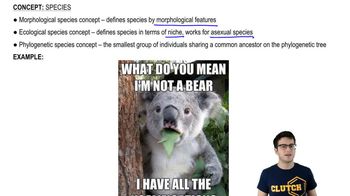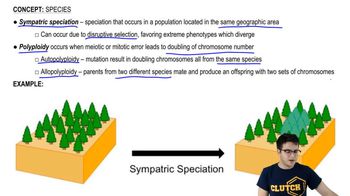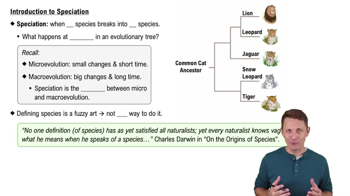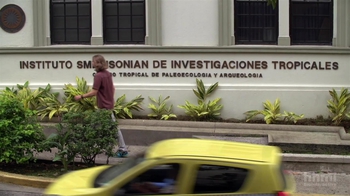>Ploidy >Let's use this simplified cell, which represents a diploid plant cell, to examine how changes in a cell's ploidy can contribute to the formation of new plant species. >This cell has two sets of chromosomes (ploidy = 2n), each set consisting of one red and one blue chromosome. >In a pair of homologous chromosomes, one chromosome originates from the female parent—indicated by the stippling—and the other originates from the male parent. >When a diploid cell undergoes meiosis, it normally produces four haploid daughter cells, each with one set of chromosomes (ploidy = n). >Nondisjunction in Meiosis >Every so often, an error called nondisjunction occurs in meiosis, and some daughter cells get too many chromosomes, while others get too few. >Nondisjunction can occur in meiosis I or meiosis II, but here we'll look at an example in meiosis I. >In meiosis I, chromosomes would normally segregate from each other, with the chromosomes of each homologous pair going to opposite poles. >However, in this case, all the chromosomes migrate to one pole. >One daughter cell has no chromosomes and the other has four. >The cell with four chromosomes continues through meiosis II. >The chromosomes line up at the middle of the cell, and the sister chromatids separate. >The cell divides, producing two cells. >Through nondisjunction, a diploid parent cell has produced two diploid gametes. >In contrast, normal meiosis results in four haploid gametes. >They're called gametes here for simplicity, but keep in mind that in plants the production of gametes requires many more steps. >What would happen if two diploid gametes came together during fertilization? >Forming an Autopolyploid Zygote >When two diploid gametes fuse during fertilization, the resulting zygote is a polyploid cell, meaning that it has more than two sets of chromosomes. >A cell with four sets (ploidy = 4n) is more specifically called a tetraploid. >This cell can also be called an autopolyploid, because the doubled chromosomes are from the same species. >The prefix auto means "self." >Meiosis in a Tetraploid >Polyploid plants survive perfectly well, but they cannot produce fertile offspring when mating with their diploid counterparts. >To see why, we'll observe several rounds of meiosis and fertilization. >First, let's see how a tetraploid undergoes meiosis. >Like all cells, it first replicates its DNA. >During meiosis, the homologous chromosomes may come together in pairs, in fours, or in other arrangements. >The cell divides during meiosis I. It divides again during meiosis II. The result is four diploid gametes. >Fertilization of Diploid Gametes >Let's now consider the act of fertilization. >When two normal, haploid gametes fuse, the result is a normal, diploid zygote. >If two of these diploid gametes came together in fertilization, the result would be another tetraploid zygote that would continue the generations of tetraploids. >However, when one of these gametes fertilizes a haploid gamete from a normal diploid plant, the resulting zygote has three sets of chromosomes (ploidy = 3n). It is triploid. >Meiosis in a Triploid >Although a triploid zygote typically develops into a viable plant, meiosis in the triploid is a confusing affair. >Before meiosis, the cell replicates its DNA. >During meiosis I, the homologous chromosomes undergo synapsis. >The extra chromosomes lack homologs; they may pair with the other two, or they may not. The cell divides. >Each daughter cell receives a unique assortment of chromosomes. >The cells divide again during meiosis II. >In this case of triploidy, all the gametes have an extra chromosome and are designated n + 1. >In a system with more chromosomes than this example, every gamete has a different assortment of extra chromosomes. >Apparently, this imbalance prevents seeds and pollen from developing normally. >Many so-called seedless cultivars, such as bananas and watermelon, are triploids. >Tetraploid gametes, on the other hand, have a balanced number of chromosomes. >Because the tetraploid and diploid plants mate to produce sterile triploids, they are reproductively isolated and are considered two separate species. >Reproductive Isolation of Allopolyploids >These diploid cells are from two different plant species. >If the plants mate and create hybrid offspring, speciation can result. >One of the cells has a diploid number of 4 chromosomes, and the other has a diploid number of 6. >When these cells undergo meiosis, they produce cells with haploid numbers of 2 and 3 chromosomes, respectively. >Let's say that pollen from one species fertilizes an ovule from the other. >In this case, the hybrid zygote may be viable, because the sets of chromosomes it receives from each parent are complete. >However, because the chromosomes don't exist in matching pairs, this zygote is essentially haploid, with a haploid number of 5. >Without pairing chromosomes, a cell cannot divide by meiosis. >But it can divide by mitosis. >If a nondisjunction error occurs in mitosis, the cell's ability to divide by meiosis can be restored. >Before mitosis occurs, the cell replicates its DNA so that each chromosome consists of two chromatids. >The chromosomes move to the middle of the cell. >In this case of nondisjunction, all of the chromosomes move to one pole of the cell as the cell divides. >The daughter cell that receives the chromosomes is now diploid, and it has a diploid number of 10. >A cell with pairs of chromosomes can divide by meiosis, producing gametes with 5 chromosomes. >These gametes can fertilize each other, resulting in a diploid zygote with 10 chromosomes. >This zygote represents the beginning of a new species. >It contains all the chromosomes from its two parent species, >but is now reproductively isolated from its parents because they all have different numbers of chromosomes. >An individual of species C is an example of an allopolyploid, >which is formed by combining gametes containing chromosomes of two distinct sets, >followed by an error—such as nondisjunction—that results in chromosome doubling. >Speciation based on allopolyploidy is common in wild plant species.
Table of contents
- 1. Introduction to Biology2h 40m
- 2. Chemistry3h 40m
- 3. Water1h 26m
- 4. Biomolecules2h 23m
- 5. Cell Components2h 26m
- 6. The Membrane2h 31m
- 7. Energy and Metabolism2h 0m
- 8. Respiration2h 40m
- 9. Photosynthesis2h 49m
- 10. Cell Signaling59m
- 11. Cell Division2h 47m
- 12. Meiosis2h 0m
- 13. Mendelian Genetics4h 41m
- Introduction to Mendel's Experiments7m
- Genotype vs. Phenotype17m
- Punnett Squares13m
- Mendel's Experiments26m
- Mendel's Laws18m
- Monohybrid Crosses16m
- Test Crosses14m
- Dihybrid Crosses20m
- Punnett Square Probability26m
- Incomplete Dominance vs. Codominance20m
- Epistasis7m
- Non-Mendelian Genetics12m
- Pedigrees6m
- Autosomal Inheritance21m
- Sex-Linked Inheritance43m
- X-Inactivation9m
- 14. DNA Synthesis2h 27m
- 15. Gene Expression3h 20m
- 16. Regulation of Expression3h 31m
- Introduction to Regulation of Gene Expression13m
- Prokaryotic Gene Regulation via Operons27m
- The Lac Operon21m
- Glucose's Impact on Lac Operon25m
- The Trp Operon20m
- Review of the Lac Operon & Trp Operon11m
- Introduction to Eukaryotic Gene Regulation9m
- Eukaryotic Chromatin Modifications16m
- Eukaryotic Transcriptional Control22m
- Eukaryotic Post-Transcriptional Regulation28m
- Eukaryotic Post-Translational Regulation13m
- 17. Viruses37m
- 18. Biotechnology2h 58m
- 19. Genomics17m
- 20. Development1h 5m
- 21. Evolution3h 1m
- 22. Evolution of Populations3h 52m
- 23. Speciation1h 37m
- 24. History of Life on Earth2h 6m
- 25. Phylogeny2h 31m
- 26. Prokaryotes4h 59m
- 27. Protists1h 12m
- 28. Plants1h 22m
- 29. Fungi36m
- 30. Overview of Animals34m
- 31. Invertebrates1h 2m
- 32. Vertebrates50m
- 33. Plant Anatomy1h 3m
- 34. Vascular Plant Transport2m
- 35. Soil37m
- 36. Plant Reproduction47m
- 37. Plant Sensation and Response1h 9m
- 38. Animal Form and Function1h 19m
- 39. Digestive System10m
- 40. Circulatory System1h 57m
- 41. Immune System1h 12m
- 42. Osmoregulation and Excretion50m
- 43. Endocrine System4m
- 44. Animal Reproduction2m
- 45. Nervous System55m
- 46. Sensory Systems46m
- 47. Muscle Systems23m
- 48. Ecology3h 11m
- Introduction to Ecology20m
- Biogeography14m
- Earth's Climate Patterns50m
- Introduction to Terrestrial Biomes10m
- Terrestrial Biomes: Near Equator13m
- Terrestrial Biomes: Temperate Regions10m
- Terrestrial Biomes: Northern Regions15m
- Introduction to Aquatic Biomes27m
- Freshwater Aquatic Biomes14m
- Marine Aquatic Biomes13m
- 49. Animal Behavior28m
- 50. Population Ecology3h 41m
- Introduction to Population Ecology28m
- Population Sampling Methods23m
- Life History12m
- Population Demography17m
- Factors Limiting Population Growth14m
- Introduction to Population Growth Models22m
- Linear Population Growth6m
- Exponential Population Growth29m
- Logistic Population Growth32m
- r/K Selection10m
- The Human Population22m
- 51. Community Ecology2h 46m
- Introduction to Community Ecology2m
- Introduction to Community Interactions9m
- Community Interactions: Competition (-/-)38m
- Community Interactions: Exploitation (+/-)23m
- Community Interactions: Mutualism (+/+) & Commensalism (+/0)9m
- Community Structure35m
- Community Dynamics26m
- Geographic Impact on Communities21m
- 52. Ecosystems2h 36m
- 53. Conservation Biology24m
23. Speciation
Introduction to Speciation
Video duration:
7mPlay a video:
Related Videos
Related Practice

















